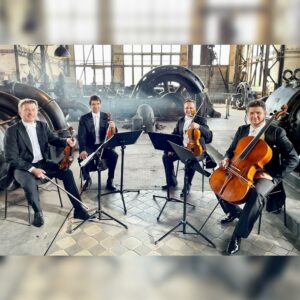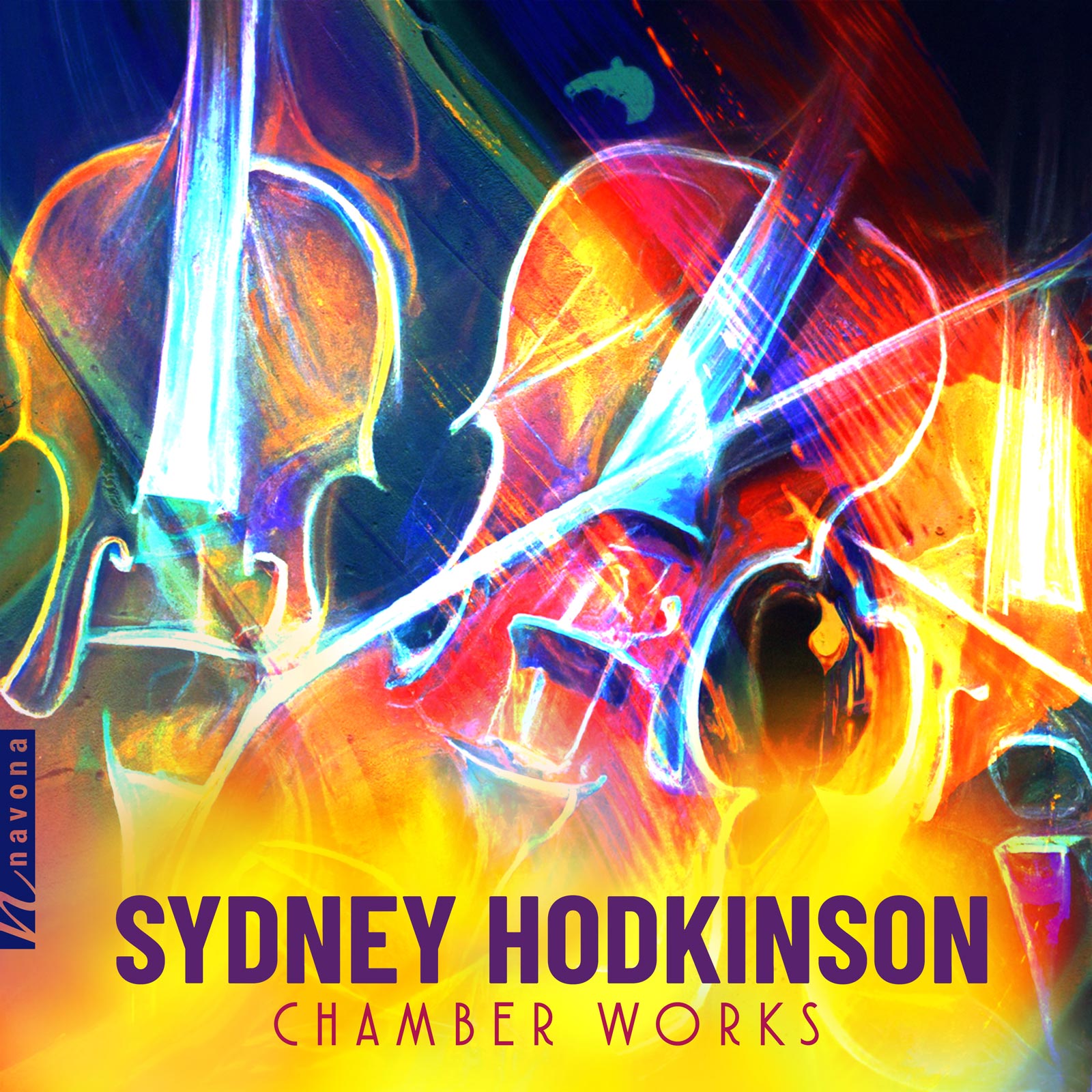Sydney Hodkinson: Chamber Works
Sydney Hodkinson composer
Throughout his lifetime, composer Sydney Hodkinson wrote over 250 works, covering a wide array of genres including educational literature, chamber arrangements, and large-scale orchestral pieces. SYDNEY HODKINSON: CHAMBER WORKS from Navona Records brings four live recordings of the late composer’s string quartets and a trio, Rogatio Gravis, to life with performances from the Benda Quartet and the Jupiter Quartet. With works written in dedication to family members, loved ones, and friends, this posthumous release serves as a perfect parting gift from Hodkinson — a musical display of his compositional prowess and kindness.
Listen
Stream/Buy
Choose your platform
Track Listing & Credits
| # | Title | Composer | Performer | |
|---|---|---|---|---|
| DISC ONE | ||||
| 01 | String Quartet No. 6: I. Tranquillo - Audace - Risoluto | Sydney Hodkinson | Benda Quartet | Jakub Černohorský, violin; Ondřej Pustějovský, violin; Petr Benda, viola; Tomáš Svozil, cello | 11:06 |
| 02 | String Quartet No. 6: II. Energice - Strepitoso | Sydney Hodkinson | Benda Quartet | Jakub Černohorský, violin; Ondřej Pustějovský, violin; Petr Benda, viola; Tomáš Svozil, cello | 6:02 |
| 03 | String Quartet No. 8: I. Violin Duo - Spiritoso | Sydney Hodkinson | Benda Quartet | Jakub Černohorský, violin; Ondřej Pustějovský, violin; Petr Benda, viola; Tomáš Svozil, cello | 4:54 |
| 04 | String Quartet No. 8: II. Cello - Allegro me non troppo | Sydney Hodkinson | Benda Quartet | Jakub Černohorský, violin; Ondřej Pustějovský, violin; Petr Benda, viola; Tomáš Svozil, cello | 4:15 |
| 05 | String Quartet No. 8: III. Viola - Adagio | Sydney Hodkinson | Benda Quartet | Jakub Černohorský, violin; Ondřej Pustějovský, violin; Petr Benda, viola; Tomáš Svozil, cello | 8:33 |
| 06 | String Quartet No. 8: IV. Tutti - Allegro Giocoso | Sydney Hodkinson | Benda Quartet | Jakub Černohorský, violin; Ondřej Pustějovský, violin; Petr Benda, viola; Tomáš Svozil, cello | 3:56 |
| DISC TWO | ||||
| 01 | String Quartet No. 7: I. Molto risoluto - feroce | Sydney Hodkinson | Jupiter String Quartet | Nelson Lee, violin; Meg Freivogel, violin; Liz Freivogel, viola; Daniel McDonough, cello | 7:58 |
| 02 | String Quartet No. 7: II. Passacaglia (Homage to Benjamin Britten) | Sydney Hodkinson | Jupiter String Quartet | Nelson Lee, violin; Meg Freivogel, violin; Liz Freivogel, viola; Daniel McDonough, cello | 9:12 |
| 03 | String Quartet No. 5: I. Introduction: con giustezza -sostenuto - vigoroso | Sydney Hodkinson | Jupiter String Quartet | Nelson Lee, violin; Meg Freivogel, violin; Jonathan Vinocour, viola; Daniel McDonough, cello | 12:10 |
| 04 | String Quartet No. 5: II. Introduction: con anima - oscuro | Sydney Hodkinson | Jupiter String Quartet | Nelson Lee, violin; Meg Freivogel, violin; Jonathan Vinocour, viola; Daniel McDonough, cello | 8:24 |
| 05 | Rogatio Gravis | Sydney Hodkinson | Joaquin Valdepeñas, clarinet; Mayumi Kanagawa, violin; Joshua Roman, cello | 8:28 |
String Quartet No. 6, No. 8
Recorded June 2022 at Dům Kultury města Ostravy (The Ostrava House of Culture) in Ostrava, Czech Republic
Session Producer Jan Košulič
Session Engineer Aleš Dvořák
Editing, Mixing Jan Košulič
Additional Editing Melanie Montgomery
String Quartet No. 7, No. 5
Recorded July 2015 at the Aspen Music Festival in Aspen CO
Recording details unknown
Rogatio Gravis
Recording details unknown
Mastering Melanie Montgomery
Executive Producer Bob Lord
A&R Director Brandon MacNeil
A&R Danielle Sullivan
VP of Production Jan Košulič
Production Director Levi Brown
Audio Director Lucas Paquette
Production Assistant Martina Watzková
VP, Design & Marketing Brett Picknell
Art Director Ryan Harrison
Design Edward A. Fleming
Publicity Brett Iannucci
Artist Information

Sydney Hodkinson
Born in Winnipeg, Canada, Sydney Hodkinson (January 17, 1934 – January 10, 2021) led an impressive career in conducting, composition, and music education, having received a bachelor’s and master’s of music from the Eastman School of Music, and a doctorate of musical arts from the University of Michigan in 1968.

Benda Quartet
Since the Benda Quartet began performing in 2012 they have achieved a wide variety of musical successes and established themselves among highly respected Czech ensembles. Their first significant landmark was the concert debut they performed at the 60th Jubilee of the Janacek Philharmonic Orchestra in Ostrava in April 2014. The concert was recorded by Czech Radio and garnered a huge audience acclaim. Since then has the collaboration with the studio of Czech Radio continued on regular basis and resulted in a number of publicly appreciated recordings. The Benda Quartet have worked intensively together with the Janáček Philharmonic Orchestra and artist management agency Janáčkův Máj on numerous chamber music and educational projects.

Jupiter String Quartet
The Jupiter String Quartet is a particularly intimate group, consisting of violinists Nelson Lee and Meg Freivogel, violist Liz Freivogel (Meg’s older sister), and cellist Daniel McDonough (Meg’s husband, Liz’s brother-in-law). Now enjoying their 20th year together, this tight-knit ensemble is firmly established as an important voice in the world of chamber music.
Joaquin Valdepeñas
A prolific recording artist, Joaquin Valdepeñas won his second Juno Award for his recording, Levant, with his Amici Chamber Ensemble, and was a GRAMMY Award nominee for two years in a row in the chamber music category — both on the Sony BMG label as part of his ARC Ensemble collaboration.
Mayumi Kanagawa
Mayumi Kanagawa (1994) is a Berlin based, Japanese-American violinist praised for her rich, dark sound and focused, engaging musicality, active as both soloist and chamber musician in Europe, Japan, and the United States.
Mayumi has performed with many orchestras including the Mariinsky Orchestra, NHK Symphony Orchestra, Belgian National Symphony, Finnish Radio Symphony Orchestra, among others. Her unique talent for communicating the love and joy of music making in varied repertoire and venues has also brought her to many outreach programs and schools around the world, from San Francisco to Novosibirsk.
Mayumi’s musical education has been shaped by Kolja Blacher, Yoshiko Nakura, Masao Kawasaki, and Robert Lipsett.
Joshua Roman
Joshua Roman is a cellist, accomplished composer, and curator whose performances embrace musical styles from Bach to Radiohead. Before setting off as a soloist, Roman was the Seattle Symphony’s principal cellist – a job he began at 22 years old and left only two years later. He has since become renowned for his genre-bending repertoire and wide-ranging collaborations.

